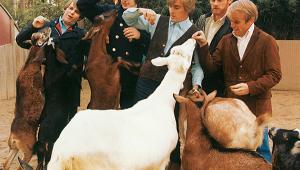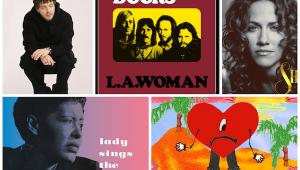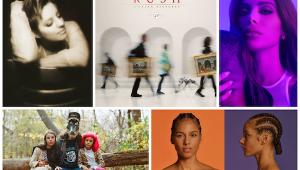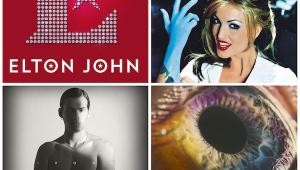I like your ideas and and in summer these are the best options to use. Also. while doing the soft washing we can find the best music of our choice that make us energetic to do our job.
I’ve Got Spatial Audio in My Head Everywhere I Go

It’s interesting how some people refer to certain summertime activities as either “hot” things to do, or “cool” things to do. When it comes to summertime listening, I tend to think it’s an intersection of both concepts. And when it comes to what I listen to for review in each weekly Spatial Audio File column during these summertime months, I consider certain tracks to be “smokin’ hot” and others to be as “cool as can be”—and sometimes, they’re actually some combo of both ideas together.
As always, each of the five hot/cool tracks that follow has been thoroughly spec’ed and checked by way of my personal deep-dive listening sessions on both my home system and headphones alike. You’ll find access to each and every one of them, alongside a gaggle of other stellar Made for Spatial Audio and Dolby Atmos cuts, within the ever-expanding Apple Music library.
And now, I give you this week’s hot-and-cool combo platter of five wonderfully immersive tracks, which are as follows. . .

ROBIN THICKE: “BLURRED LINES (FEAT. T.I. & PHARRELL)”
Canadian/American singer/songwriter Robin Thicke’s worldwide chart-topping smash “Blurred Lines” stirred many an emotion both above and below the belt upon its initial release in 2013 (and in some of its ensuing years as well), but it garners a whole new life above the fray in Dolby Atmos.
An insistent synth pulse doubled by a muted drumbeat strike collectively up the middle three times before a fast halt—and then Pharrell chimes in over on the far, far left to declare: “Everybody get up!” The pulsing returns, this time with percussive cowbell, chimes, and other percussion percolating just right of center and pinging further to the right and back. A Michael Jacksonesque “hoo!” pops out of the ether, and the song’s instantly recognizable “Hey hey hey!” interjection flies in at the far left, then slides over to the right.
The opening lead vocal emerges way up on high, falsetto in full effect, starting with, “If you can’t hear what I’m trying to say.” Thicke’s lower tone follows that right down the middle with “Maybe I’m going deaf / Maybe I’m going blind.” Answer vocals punctuate each line high up to both the left and the right and not always in the same place, as if they’re in-the-moment thoughts buzzing around Thicke’s head.
When the layered vocals on the line “you’re a good girl” spread far and wide across the stage, you can hear Thicke’s Robert Palmer vocal-inflection influence coming through loud and clear. Each successive portion of this verse section varies from line to line, as does the weight and emphasis of the call-and-response vocals and the percussive bed track. Note how each run at the phrase “good girl” is altered, with Thicke holding the “ouh” in “good” and the “irr” in “girl” longer, shorter, and/or with different emoting intention each time. No line reading in “Blurred Lines” is ever really the same—likely a combo call between Thicke’s own vocal choices and Pharrell’s overall production acuity, the latter of which is on full display during every second of this track.
Handclaps from above accent the transition into the next brief falsetto section. Thicke’s lead returns mostly left of center, and he enunciates “domesticate” in such a way that you can essentially visualize the air quotes around the word itself. T.I.’s suggestive rap section floats in above the plane at center left, with certain words in delayed-echo form following at center right. The synth pulse and cowbell percussion remain strong up the middle to anchor every vocal element that continues to swirl all around the joint. You should even hear those recurring chimes slightly buried in the mix here as well.
Barring its admittedly controversial lyrical content, the song’s truly exciting production values are what can’t get past me. With all that in mind, “Blurred Lines” is quite clearly in focus as our Made for Spatial Audio track of the week.

WEEZER: “RECORDS”
Weezer is truly a band for all seasons, a winning characteristic readily on display all throughout June 2022’s SZNZ: Summer EP. It’s the second, seven-track entry in the acclaimed L.A. emo/alt-rock collective’s all-season suite of sorts, and one of its top cuts, “Records,” is as engagingly immersive as a perfect summer day in Spatial Audio.
Head Weezer-master Rivers Cuomo opens the track in the middle and up on high with the telling (and instantly relatable) line, “I’ve got records in my head everywhere I go.” The thrust of the opening portion of the backing track immediately brings Brian Wilson and The Beach Boys to mind—as it should. “They go round and around / and again,” Cuomo repeats, as the percussive buildup behind him increases in volume, resulting in a swift drumming-punch payoff.
As Cuomo returns to the phrase “I’ve got records in my head,” that patented Weezer guitar crunch comes to the fore of the mix, punctuated over to the left and resonating over to the right. The repetitive rhythm of this vocal phrase mirrors the hypnotic effect of watching the label on one of your favorite 45s spinning endlessly on your turntable—or, more likely, on the first portable record player you had as a kid.
When Cuomo observes, “I’m pillow-drumming on the sofa,” the backing track clears out enough so that the accompanying bassline and drum beat hold down the middle fort, even as his vocals waft a bit from center left to center right.
By the time he returns to the next slam-bang “records in my head” chorus, you should be singing along in your own head, which by now should also be reflexively bouncing and/or headbanging along to the beat. I challenge you to remain quiet when Cuomo punctuates this section with a resounding “Oh yeah!” up in the clouds.
“Ooh, I feel Nirvana” (capital N very much intended) is declared up in the sky, followed by an elegiac “woo” or two—perfectly capturing the consummate record fan’s listening-related emotions and elations to an LP—er, I mean, to a T. Like Cuomo, I don’t feel no pain—just the scratches—each time I cue up “Records” in all its Spatial Audio glory. Spin on, brotha!

REGINA SPEKTOR: “BECOMING ALL ALONE”
Russian/American singer/songwriter Regina Spektor is a bonafide indie-pop icon, and her deeply touching June 2022 album, Home, Before and After, has only served to increase the worthiness of the mantle. The album’s lead track, “Becoming All Alone,” is as affecting as anything you’ll hear in Spatial Audio.
Spektor takes a noticeable breath before delivering her first line, “I went walking home alone” right above the left-center plane. She accompanies herself on piano from the outset, and the chords she strikes both sustain and resonate mostly to the left. The next lines of the first verse fully recenter themselves, still on high but well out front in the mix. The piano notes are clearly behind her as string accompaniment enters high and center-left just as she sings the last word in the phrase, “When I heard God call out my name.”
Her piano playing picks up the pace, spread wide as the strings now envelop the full stage parallel with the line, “He said, ‘Hey, let’s grab a beer.’” Spektor has a fairly similar humanizing spin on the God that Joan Osborne speculates about in her classic 1995 hit “One of Us”—though Spektor does admit to him being “revered” as the conversation continues.
Spektor’s way of wrapping her voice around particular words as if she’s trying on new clothes is evident with the lilt added to words like “time,” “all,” and especially “stay,” a word repeated like a pleading mantra throughout the rest of the track. (For more on this facet of Spektor’s particular vocal character, cue up “You’ve Got Time,” which became the theme to the acclaimed 2013-19 Netflix dramedy Orange Is the New Black.)
The strings build in volume and rise to the clouds right as the drum track finally kicks in, all chest-thumping and deep up the middle. (Yes, this is the part in Spatial Audio File where I insert my weekly “check ya subwoofer” warning.) The drums remain as loud as Spektor’s vocal is for the next group of lines while the strings fan outward to lend more room to that middle berth, clearing the way for horns to now enter into the center-left fray.
After another “stay, stay, stay” reverie, the strings take over for an all-field solo section, in turn becoming the loudest element in the track as the drums are rightly pulled back and the horn accents roll to the left. Then it’s just Spektor’s voice and her plaintive piano, revisiting the opening verses with a heavier heart. The strings return above at just the right moment when her appeals to “stay” move all across the plane until the final piano-chord fade.
“Why doesn’t it get better with time?” Spektor asks rhetorically more than once. Good news, Regina—“Becoming All Alone” actually makes it all a little bit better, and brings us all a little bit closer together, in Atmos.

LANG LANG: “FEED THE BIRDS (FROM ‘MARY POPPINS’)”
Chinese classical piano prodigy Lang Lang has decided to put his own spin on an album’s worth of Disney classics called, appropriately enough, The Disney Book (Deluxe Edition), which is set for a September 2022 release. A few months ahead of the full album, Lang Lang has shared his interpretation of a particularly mournful Mary Poppins classic, “Feed the Birds,” and it absolutely soars in Atmos.
Solo piano, especially when performed at the highest level by artists of Lang Lang’s stature, is a truly magical listening experience in Atmos, as the clarity of the artist’s note and chord choices, the character of the piano itself, and the physical space the piece is performed in should all be quite palpable, just as if it were being played right in front of you.
“Feed the Birds” starts somewhat quietly, with Lang Lang taking his time with the note choices of a melody that is likely familiar to many a listener of the various ways it recurs in the 1964 Mary Poppins film, as well as in Julie Andrews’ version on the soundtrack. Here in the present day, the held piano notes ring and sustain across the field, and you should even hear Lang Lang take a breath in the moment around 25 seconds into the track.
His playing begins to get louder in the middle field with the notes he chooses to emphasize, their resonance spreading outward while Lang Lang continues forward, adjusting the tempo as needed. The spatial relationship of certain notes and chords in the overall field corresponds with where Lang Lang’s hands are on the piano keys themselves. (You’ll also hear him take other breaths all throughout the piece, btw.)
If you need a change of pace in your listening queue today, then you’ve come to the right place. “Feed the Birds” is just the right sonic seed to feed your soul in Atmos.

SELENA: “DREAMING OF YOU”
Mexican/American vocalist Selena sadly left this world way too soon at age 23 in early 1995, but her undeniable artistic legacy continues to live on in the hearts and minds of older and newer generations alike. “Dreaming of You,” the romantic ballad title track to her posthumous multiplatinum July 1995 album, has added resonance in Spatial Audio.
Piano and chimes open the track, with the chimes ringing left-to-right and back across the entire soundfield, essentially setting the stage for the song’s titular dream state. Selena arrives above and in the middle, taking a short breath before she admits, “Late at night when all the world is sleeping / I stay up and think of you.” As Selena continues breathily in the first verse, out front in the mix and still on high, a crisp acoustic guitar figure joins behind her before a deliberate accent chord pans across the stage just before she gets to the line, “’Cause I’m dreaming of you tonight.”
As the chorus unfolds, the backing instrumentation becomes louder, with full drums arriving behind her in the middle. Selena’s own backing vocals, along with background vocalist Delphine’s, are sometimes a beat behind the lead. When Selena extends the vowel in the final word of the phrase “dreaming of me,” triangle hits and electric guitar fill in behind her.
Selena’s vocals on the next verse nestle just a tick left of center, her occasional whispered responses arriving just to the left of the lead. The track’s overall bright presentation and clean production style—coordinated by her father, Abraham Quintanilla, Jr.—pave the way for Selena’s voice to wholly own the dream at hand with no instrumental impediments. Acoustic guitar lines and synth strings always respond to and support whatever Selena sings, rather than dominate any of the in-between-vocals moments.
The Spanish-and-English juxtaposed bridge briefly reinforces why Selena was known as the Queen of Tejano music. Selena carries the track home in an unbridled expressive manner, followed toward the end by a very much earned Spanish guitar figure up the middle to close out the proceedings. Overall, this song serves as a nice reminder that we could all use a romantic ballad in our lives every once in a while. In short, “Dreaming of You” is a dream realized in Spatial Audio.
Related:
HOW TO GET THE MOST OUT OF SPATIAL AUDIO
For more about the specs, gear, and setup options you’ll need to experience the very best of the ever-expanding Apple Music universe of fully immersive Made for Spatial Audio Dolby Atmos mixes, go here.
FURTHER LISTENING
Still want more Made for Spatial Audio options to listen to before an all-new Spatial Audio File returns next Friday? Go to Apple Music: Spatial Audio Relations to get an additional all-channel fill.
- Log in or register to post comments


You are good to bring these ideas with us here. As winter is about to complete and summer things are in our mind these ideas are good. When we check that ideas to use.






























































